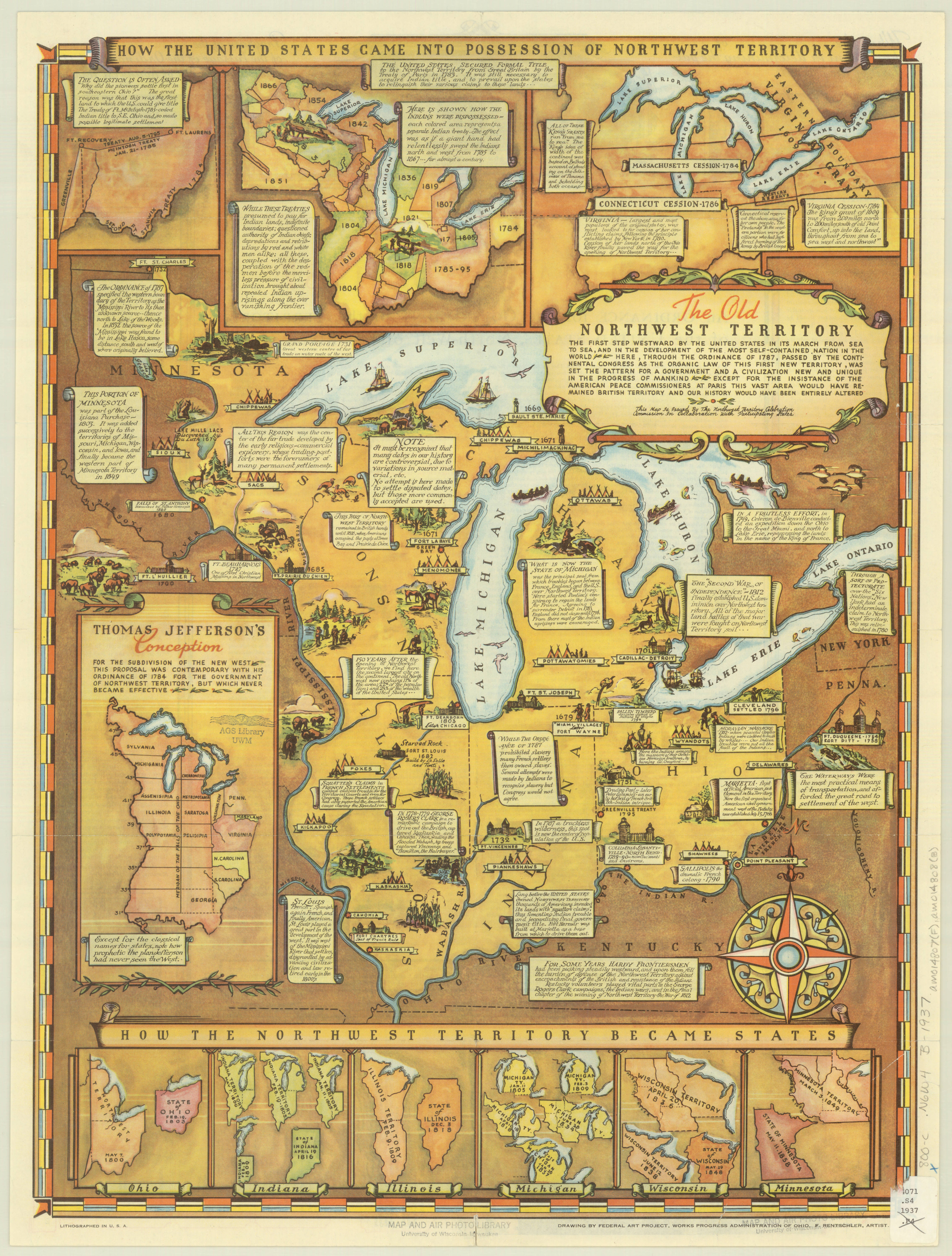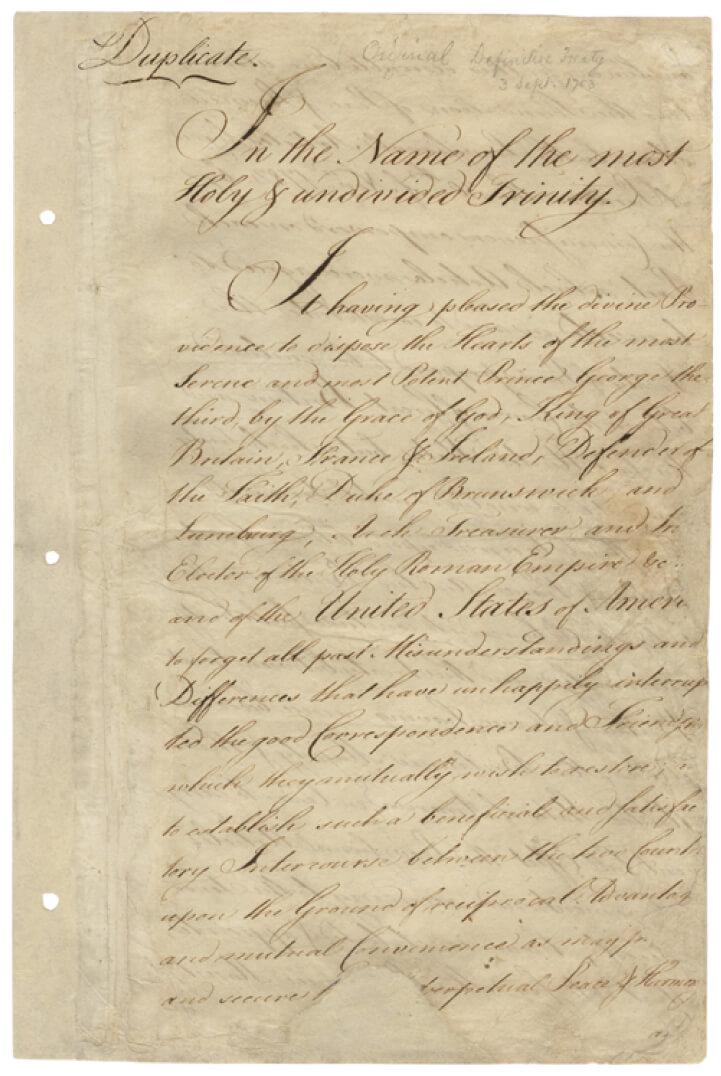The Northwest Territory was the United States' first post-colonial organized incorporated territory, established after the Revolutionary War. This territory eventually became the states of Illinois, Indiana, Michigan, Ohio, Wisconsin, and the northeastern part of Minnesota.

Key Milestones in the Establishment of the Northwest Territory:
The Treaty of Paris (1783)
The Treaty of Paris, signed on September 3, 1783, between the American colonies and Great Britain, ended the American Revolution. It formally recognized the United States as an independent nation and delineated boundaries that allowed for American western expansion. The United States secured title to the Northwest Territory from Great Britain through this treaty.

However, acquiring Indian Title and prevailing upon states to relinquish their claims required three successive ordinances passed by the Congress of the Confederation.
New York's Claim to the Northwest Territory
New York had a vague claim to parts of the Northwest Territory because of its influence over the "Six Nations" of the Iroquois Confederacy. This claim was relinquished in 1780, clearing the way for federal management of the territory.
Additional State Cessions
Following New York's example, other states also gave up their claims to parts of the Northwest Territory:
- Connecticut: Connecticut had claims to land in the western part of the Northwest Territory, known as the Western Reserve. In 1786, Connecticut ceded most of its claims to the federal government but reserved the Western Reserve for its own people. The western portion, called the "Firelands," was set aside for citizens who had their homes burned by British troops during the Revolutionary War. Connecticut later ceded the Western Reserve in 1800.
- Pennsylvania: Pennsylvania's claims to land in the Northwest Territory were minor and quickly resolved, allowing for federal control.
- Virginia: Virginia had significant claims to the Northwest Territory based on colonial charters. In 1784, Virginia ceded its claims to the federal government but retained a portion known as the Virginia Military District to reward Revolutionary War veterans.
These cessions allowed the federal government to take control and organize the territory, paving the way for the creation of new states.
Acquiring Indian Title
Acquiring Indian Title, or the legal right to lands held by Native American tribes, was a crucial step in settling the Northwest Territory. The process involved negotiations and treaties with various tribes to extinguish their claims to the land. Key treaties included:
- Treaty of Fort Stanwix (1784): This treaty with the Iroquois Confederacy ceded lands in the Ohio Valley to the United States.
- Treaty of Fort McIntosh (1785): This treaty involved the Delaware, Wyandot, Ottawa, and Chippewa tribes, who ceded lands in what is now Ohio and western Pennsylvania.
- Treaty of Fort Harmar (1789): This treaty reaffirmed earlier agreements and expanded U.S. claims in the Ohio Valley.
Despite these treaties, conflicts between settlers and Native American tribes continued, leading to further military engagements and treaties.
Northwest Ordinance of 1784
In 1784, Thomas Jefferson's vision for America's western territories took shape with the drafting of the Ordinance of 1784. Tasked by Congress to govern lands beyond the Appalachian Mountains and west of the Mississippi River, Jefferson proposed a framework dividing this vast area into self-governing districts, each poised to enter the Union as sovereign states once their population equaled that of the smallest existing state.
Key Articles from the Ordinance of 1784:
- The new states shall remain forever part of the United States of America.
- They shall bear the same relation to the confederation as the original states.
- They shall pay their apportionment of federal debts.
- They shall uphold republican forms of government.
- After the year 1800, there shall be neither slavery nor involuntary servitude in any of them.
Jefferson had conceptually proposed creating ten roughly rectangular states from the territory with suggested names such as Cherronesus, Sylvania, Assenisipia, Illinoia, Metropotamia, Polypotamia, Pelisipia, Washington, Michigania, and Saratoga. However, this plan never became effective.

The Congress of the Confederation modified the proposal, passing it as the Land Ordinance of 1784.
Land Ordinance of 1785
The Land Ordinance of 1785, drafted by Thomas Jefferson, established a standardized system for surveying and distributing land in the Northwest Territory. Key points include:
- Land Survey System: Townships were divided into 36 sections of one square mile each (640 acres).
- Sections for Public Use: Section 16 of each township was reserved for public schools, setting a precedent for federal support of public education.
- Land Sale Process: Land was sold at public auction with a minimum price of $1 per acre.
- Revenue for Government: Proceeds from land sales were intended to help pay off the national debt and encourage westward expansion.
- Rectangular Survey System: This system established a grid pattern still in use today in many parts of the United States.
Northwest Ordinance of 1787
The Ordinance of 1787, also known as the Northwest Ordinance, was a landmark piece of legislation establishing governance for the Northwest Territory. Key points include:
- Territorial Government: Initially governed by a governor, a secretary, and three judges appointed by Congress.
- Stages of Development:
- First Stage: Governed by appointed officials when the population was fewer than 5,000 free male inhabitants.
- Second Stage: A territorial legislature could be elected, and a non-voting delegate sent to Congress once the population reached 5,000 free male inhabitants.
- Third Stage: When the population reached 60,000, the territory could draft a state constitution and apply for statehood.
- Rights and Liberties: Guaranteed fundamental rights, including freedom of religion, trial by jury, habeas corpus, and due process of law.
- Prohibition of Slavery: Slavery and involuntary servitude were prohibited, setting a precedent for free states.
- Education and Civil Liberties: Encouraged the establishment of schools and fair treatment of Native Americans, though enforcement varied.
- Statehood and Equality: New states formed from the territory would be admitted to the Union on an equal footing with the original states.
Squatter's Claims in French Settlements
French settlers who had supported the American cause during the Revolution established settlements in the Northwest Territory. However, many of these settlers did not have legal claims to the land, causing ongoing disputes and issues for the Territorial Courts and even Congress.
The War of 1812
The War of 1812, often called the Second War of Independence, was crucial in establishing U.S. control over the Northwest Territory. All of the major land battles of the war were fought on Northwest Territory soil, solidifying American authority in the region.
Conclusion
The establishment and development of the Northwest Territory were pivotal in shaping the early United States. Through treaties, ordinances, and conflicts, the territory transitioned from a contested frontier to a vital part of the nation, laying the groundwork for future expansion and statehood. The policies and precedents set during this time continue to influence the United States' approach to governance, land management, and statehood.